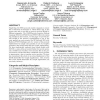Free Online Productivity Tools
i2Speak
i2Symbol
i2OCR
iTex2Img
iWeb2Print
iWeb2Shot
i2Type
iPdf2Split
iPdf2Merge
i2Bopomofo
i2Arabic
i2Style
i2Image
i2PDF
iLatex2Rtf
Sci2ools
CCS
2008
ACM
2008
ACM
Formal analysis of SAML 2.0 web browser single sign-on: breaking the SAML-based single sign-on for google apps
Single-Sign-On (SSO) protocols enable companies to establish a federated environment in which clients sign in the system once and yet are able to access to services offered by different companies. The OASIS Security Assertion Markup Language (SAML) 2.0 Web Browser SSO Profile is the emerging standard in this context. In this paper we provide formal models of the protocol corresponding to one of the most applied use case scenario (the SP-Initiated SSO with Redirect/POST Bindings) and of a variant of the protocol implemented by Google and currently in use by Google's customers (the SAML-based SSO for Google Applications). We have mechanically analysed these formal models with SATMC, a state-of-the-art model checker for security protocols. SATMC has revealed a severe security flaw in the protocol used by Google that allows a dishonest service provider to impersonate a user at another service provider. We have also reproduced this attack in an actual deployment of the SAML-based SSO ...
| Added | 12 Oct 2010 |
| Updated | 12 Oct 2010 |
| Type | Conference |
| Year | 2008 |
| Where | CCS |
| Authors | Alessandro Armando, Roberto Carbone, Luca Compagna, Jorge Cuéllar, M. Llanos Tobarra |
Comments (0)

